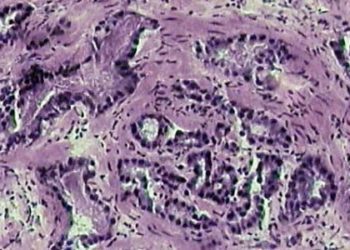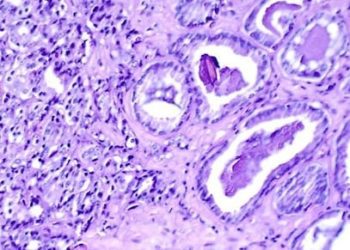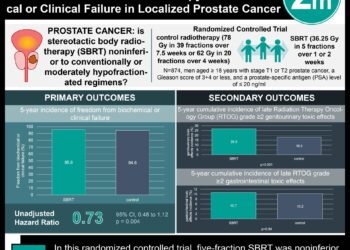Long-term active surveillance may be safe in low-risk prostate cancer
1. In a cohort of more than 900 low-risk prostate cancer patients followed for up to 15 years, 2.8% of patients developed metastatic disease and 1.5% died of prostate cancer.
2. The relative likelihood of dying from other causes compared to dying from prostate cancer death in this cohort was 9.2 to 1.
Evidence Rating Level: 2 (Good)
Study Rundown: Prostate cancer is the most common malignancies in men, with a lifetime risk of 1 in 7. Active surveillance (AS) is the process of forgoing initial definitive treatment for delayed definitive intervention when specific signs of disease progression has occurred. AS has previously been demonstrated to be effective in patients with low-risk (Gleason 6) prostate cancer, however, there has been no previous studies reporting the long-term outcomes of patients on AS. The authors of this trial presented the 15-year follow-up results of a prospective patient cohort of 993 low-risk prostate cancer patients on AS. Within this cohort, the overall survival rate was 85%, with only 15 (1.5%) reported deaths from prostate cancer and 13 (1.3%) reported cases of prostate cancer metastasis. Within this cohort, the risk associated with dying from other causes was 9.2 times greater than the risk of dying from prostate cancer. The results of this study demonstrate that AS may be a may be a safe treatment approach in low-risk prostate cancer. Furthermore, the development of new imaging techniques and molecular biomarkers (which were not used in this cohort) may detect occult high grade disease and may further help distinguish the appropriate patients for AS treatment.
Click to read the study in JCO
Relevant Reading: Active surveillance for clinically localized prostate cancer–A systematic review
In-Depth [prospective cohort]: In this prospective, single-arm cohort study, the authors enrolled a total of 993 men with low or intermediate-risk (Gleason 6-7) prostate cancer from a single academic center. Major outcomes measured included overall and disease-specific survival, rate of treatment, and PSA failure rate among treated patients. The median age was 67.8 (range: 41-89) years. The median follow-up time from first biopsy was 6.4 years (range 0.2 to 19.8 years). Over 200 patients were followed for more than 10 years and 50 patients were followed for more than 15 years. Overall, 149 patients (15%) died. Within this group, the prostate cancer specific mortality was only 1.5% (15 patients). Another 1.3% (13 patients) developed metastatic disease. The median time to metastasis was 7.3 years (95% CI: 5.81 to 8.76). 27% (267 patients) have received intervention due to disease progression. The percentage of patients that remained on AS at 5, 10, and 15 years were 75.7%, 63.5%, and 55%, respectively. Multivariate Cox proportional hazard regression analysis demonstrated that age >70 (HR: 2.87; 95% CI: 1.88 to 4.38, p<0.001), Gleason score >6 (HR: 1.70; 95% CI: 1.14 to 2.55; p<0.01) were significantly associated with decreased survival.
More from this author: Rituximab linked with reduced chronic immune disease following stem cell transplantation, High-dose prophylaxis for hemophilia increases costs with minimal benefit, Ambrisentan found ineffective against idiopathic pulmonary fibrosis
Image: CC/Wiki/Nephron
©2014 2 Minute Medicine, Inc. All rights reserved. No works may be reproduced without expressed written consent from 2 Minute Medicine, Inc. No article should be construed as medical advice and is not intended as such by the authors, editors, staff or by 2 Minute Medicine, Inc.







